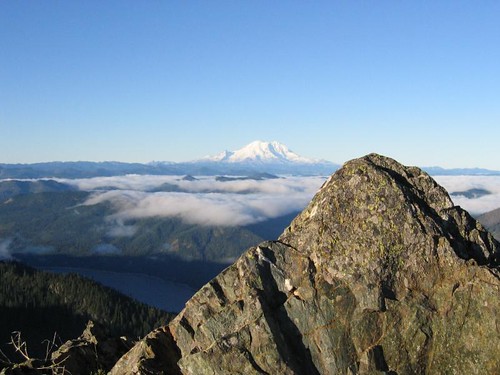
Photo of Mount Rainier (background), with Thorp Mountain summit in foreground.
Yes, this is part of the course!
Photo by Glenn Tachiyama, http://www.pbase.com/gtach/cc1002007
Cascade Crest is an ultra-running minimalist's "dream run." It harkens back to the early days of what 100-mile mountain runs used to be like, long before über-hyped runs like Western States and Leadville became synonomous with 100-mile ultra-running. In fact, Cascade Crest reminds ultrarunning old-timers a lot of what Western States and Leadville were like before they had big-name sponsors, super-stocked and well-spaced aid stations, and the large number of entrants and potential entrants wanting an entry spot. Cascade Crest has none of that. But what it does have is enough of everything you need to get through the race, and more than enough adventure to satisfy any self-sufficient nutcase ultrarunner (like myself).
I arrived in Easton after having done a fair amount of traveling. I've had a busy Summer. Our good friends from Spokane, Stacey and Randy Probst met me at our campground on the day before the race. They were going to help crew for me, just as they had last year. Ooh...last year...that's the year that I had my first experience with this race, my first true "mountain" 100-miler. I ended up dropping out, (which is called DNF'ing), at mile forty, with a torn hamstring muscle. I had tried running on it for a while, and ended up really screwing-up my lower back, as well. Those are not fond memories for me. It took a long time to fully recover.
So I had a score to settle with this course and with myself. I promised myself to train smarter and harder for the mountainous terrain. How would I do this in the Midwest, pray tell? It just so happens that I got the opportunity to go to Western States training camp in May, courtesy of my buddy Pat Perry, and I also got to pace him for the last 40 miles of Western States in June. The month afterward, I ran a 50-miler at Mount Hood, for some additional training. I had also worked some special gym training into my routine to simulate climbing uphill for up to an hour at a time, non-stop. I've got to say that this really helped, this year.
Waking up on race day is always strange at this race. Cascade Crest starts at 10 a.m., instead of a "normal" 100-mile start time of 6, 5, or even 4 a.m. The 10 a.m. start is a real pain for non-west-coasters; (that's noon, my time). So I was starting a race mid-day, that I knew I couldn't possibly finish in under 24 hours! This can be an additional source of fatigue for this race.
We got to the starting area at the fire station in Easton, about an hour before the race. I got to see a lot of my Northwest ultrarunning friends. Olga was there; Eric Barnes, Stan Holman, Kendall Kreft, and Rob Hester were also there. Olga had a big crew there to support her, including Rob.
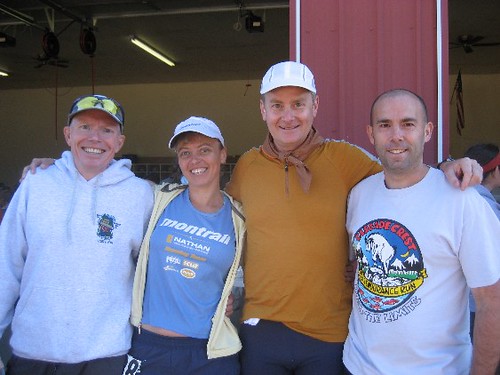
Eric, Olga, me, Rob
After a pancake breakfast and the Canadian and U.S. anthems, a fire horn blew, and we were off! The course starts on a trail and then turns onto a gravel road, and is flat for a mile. When we got to the woods, we started a "leisurely 3000-foot climb" on switch-backed trails to Goat Peak. From here it was up and down until we got over Blowout Mountain, where we picked up the Pacific Coast Trail.
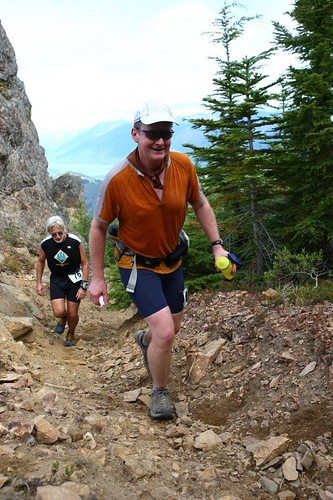
Me at Goat Peak
Photo by Glenn Tachiyama, http://www.pbase.com/gtach/cc1002007
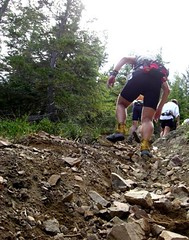
Uphill Slog.
Photo by Patrick Perry
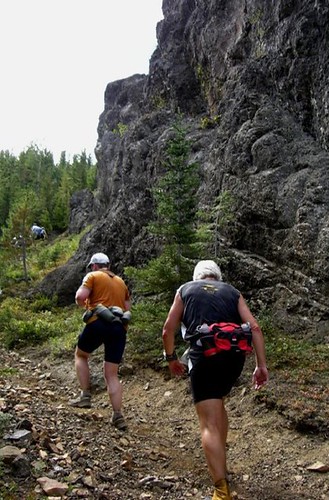
Me (on left) near Goat Peak.
Photo by Patrick Perry

Me and Pat.

Photo by Patrick Perry
My crew was waiting for me at Tacoma Pass, which was at mile 23 for me. I was feeling great, so I just filled my water bottles with water and powder, and I took off.

Course Profile to Tacoma Pass
Next on the agenda was making it to Stampede Pass aid station, where my crew would be waiting. I first had to make it to Snowshoe Butte aid station and through a few climbs and descents to reach my goal. I also had some entertainment along the way. There were a lot of wild huckleberries and thimbleberries that were ripe and ready to eat, right along the trail. I had a few, whenever I slowed down enough to grab them. I also caught up with a couple that was hiking with large packs. I said, "on your left," and the female hiker said, "no; it's my trail, too, and I won't let you pass!" She then started flailing her hiking poles and walking fast, in an attempt to keep me from passing her. I ended up bushwhacking around her quickly. Her husband (or man friend) looked embarassed as I said hi, while passing him. Quite the fun time at mile 30! This is also where it started to rain.
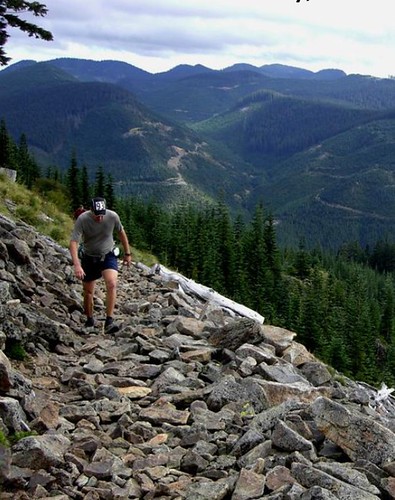
Scree section.
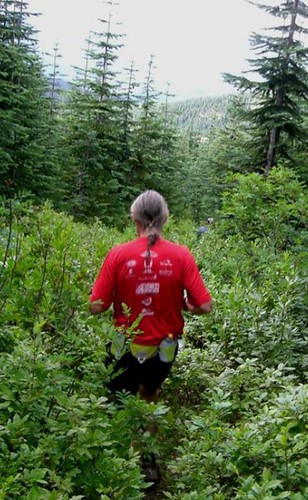
Where's the trail? A lot of trail was obscured by huckleberry bushes.

"Trail victim" being helped by other runners.
Photos by Patrick Perry
It was a light rain at first, but started picking up steam. I crossed a couple of sets of power lines that were humming loudly in the rain. One more climb and descent, and I was at Stampede Pass, (mile 33). At this point last year, I had thrown up, from having run in the heat at too fast of a pace. This year, I was a little chilled by this point. I got some food and Randy opened an O'doul's non-alcoholic brew for me. Just like it had at Western States, it really hit the spot. I took off my short sleeved top and donned my long-sleeved merino wool top, and also my feather-weight Patagonia windbreaker. I picked-up my headlamp and flashlights, because it was starting to get dark. I was feeling well and confident, so I told my crew to meet me in Hyak, a full twenty miles away.

Tacoma Pass to Hyak course profile
The next aid station to point for was Meadow Mountain. This was at the same place where I had had to drop out, the year before (with a busted hamstring). It was easier going than I remembered, but the tall bushes on both sides of the trail soaked me to the bone every time I had to wade through them. This was annoying. I finally got some more fun entertainment. A skunk appeared ahead of me on the trail. It kept looking my direction and sniffing, and wouldn't move for a full two minutes, until it finally ambled slowly into the brush.
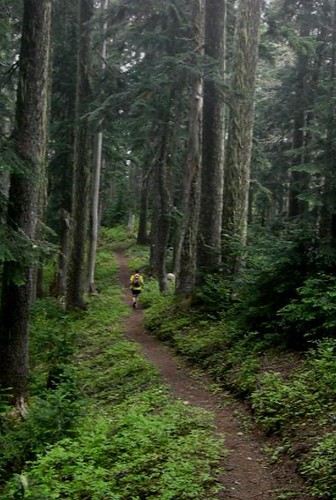
Old Growth Forest section. (by Pat Perry)
It felt like it took forever to run the seven-plus miles to Meadow Mountain. It was nice to see the aid station, but I wanted to get out of there in a hurry. I had started to feel really tired. Not tired physically, but just worn-out mentally. I pressed onward toward my next goal, Ollallie Meadows.
It was another long-ish leg of the race. The trail had become very slick with the mud and wet rocks. Sometimes I had to slow down to a slow "mall walk" to get through some technically difficult sections without slipping and breaking anything. My mental concentration wasn't in the best of shape, and neither was my equilibrium, at this point. This was not good!
I ran onward. I was cruising along just fine, or so I thought, and all of a sudden I slipped a little to the right and was gone! Gone, down a steep cliff-side, that is. I slid about 20 feet before I caught myself on the passing bushes. Somehow, I had held onto my flashlight through all of this. I pulled myself back up to the top, using the bushes on the hillside. Shannon Willford, of Kelowna, BC, came along right then, and helped me up over the edge. My disappearance and reappearance from the trail had been a little shock to her, (as well as me). I was skinned-up and bruised a little, but was still pretty much okay.
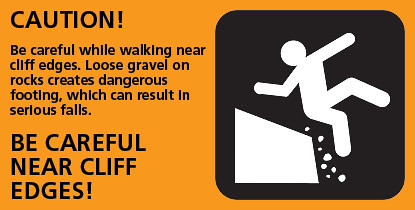
I gave a spare flashlight to Shannon, who was having lighting problems, and we took off. From this point on, my equilibrium felt trashed.
I ambled on. I got to the Ollalie Meadows aid station at mile 48, and I was hungry. I ate two hot pierogies, (a potato-based food), filled my water bottles, and left. I also had some coffee, to try to clear my head. Two guys and Shannon left slightly before me. The next section seemed to be especially trearcherous with a lot of loose rocks and overgrown trail. I took it slow, because my "sense of uprightness" (as I like to call it), was not working properly.
I finally got to a dirt road section. The road went downward at about a 25-percent grade and was covered in loose rocks. I didn't do any running on it. I was scanning to the side of the road, looking for the infamous "roped section" that I would have to climb down. Finally, I spotted it, just on the right side of the road. I also spotted something moving to my left. I looked over and saw a black bear, (which appeared to be about 400-lbs in size), standing still and looking at me and my bright set of lights. All I could muster was a muffled "hi," whereupon he decided to saunter back into the woods on his side of the road. He was not feeling conversational, obviously, and neither was I. I headed for the ropes.

Even though I was alone, I actually said out loud, "you gotta be kidding me," when I first set my eyes on the roped section. Here, in the middle of nowhere, was a rope that seemed to go forever down a steep hill, over logs and all kinds of stuff...into the dark, wet well of this crazy night. The first part went over some downed logs that were slick with rain, mud, and wet moss. I slipped and fell right away, and ended upside-down on a big log, still (thankfully) holding onto the rope. An impulsive, hysterical titter came out of my mouth. I could tell that insanity was not far away, at this point.

Photo by Patrick Perry
I decided to secure my flashlight on my belt, and to just use my headlamp while descending the rest of the way. This helped, but it still took an inordinate time to get down all of the roped sections. Part of the problem was the type of ropes that were used for this purpose, which were climbing ropes that had a 10% stretch rate. When I would get to the bottom of a long rope, it would get "real springy," and I would not feel real secure. After the race, I talked with the race director about this. I'm going to donate my 563-foot long 7/16" diameter Bluewater II static line for the roped section. This rope only has a 1% stretch rate, and feels solid as a rock while descending. I used to use it for vertical caving. I don't cave with it, anymore, and I think this would be a great addition to the race, if they choose to use it.
I finally got to the bottom. Big change: now I was standing on a rails-to-trails (wide) section of trail. I followed the markings. They led to a large concrete-framed opening in a mountain. The tunnel section! The tunnel is a 2.3-mile long abandoned railroad tunnel that goes under Snoqualmie pass. I started running, and made myself run most of the tunnel. It was great to be out of the rain and I started to dry-out and warm up. After what seemed like an eternity, but was actually only 30 minutes or so, I was on the other side.
I followed the trail for a short way, and then was funneled through a parking lot and onto some asphalt, parallel to the I-90 interstate highway. Yuck...pavement! The markings finally led me to a road that crossed I-90, and I could finally see the Hyak aid station on the other side. I heard some yells and a cowbell, as I approached.
I arrived just 1-hour ahead of the mandatory cut-off. I had lost a full 45-minutes of time on the clock in the last 14 miles or so, due to my depleted mental acuity. The two guys that had passed me and Shannon were there, but they all seemed to be taking their sweet time at the aid station. I just wanted to leave, and get going. Randy & Stacey were there to help me get moving. Randy was going to pace me for the next two sections, which were mainly dirt roads. He doesn't have any night trail experience, so this was a perfect part for him to pace me. We got our stuff together, and headed out.
We ran on a flat, paved road for about a mile, and then took a left onto a dirt road. This road goes upward for 7 full miles toward the next aid station at mile 60. I tried running parts of it, but was relegated to a walk for a lot of the uphill. I felt like crap, and Randy did his best to keep my attention from wandering. And wander it did. He later said that I wasn't making any sense, and kept slowing down and veering toward the side of the road. This was not good.
I dropped out of the Cascade Crest 100-miler at the mile 60 aid station, due to "mental fatigue." No matter what I tried, I couldn't get my head clear enough to continue. It was the safe thing to do, before I got onto any more (slick) rock-strewn trails, climbed anymore mountains, or negotiated any more cliffs.
My legs and body were fine at that point, though. If I could have screwed a new head onto my body, I could have made it just fine. Coffee and food...nothing worked to snap me out of my haze. What led to this mental demise? I've had a busy Summer. I've been working a lot of hours, traveling, race-directing races almost every weekend, doing my duties for my local Track Club and the Trail Nerds, and basically wearing myself into the ground. This was compounded by an unusually hot and humid July and August in the Midwest, which had an effect on most runner's training, including mine. I had arrived in Easton slightly exhausted, to put it lightly.
Also, I realized after the race that I was hypothermic from the constant rain and 40-degree weather for 30 miles. (I was so cold that I didn't even start shivering until I had warmed-up at the aid station for a long while, and my body temperature was sub-94F).
Some thoughts on not finishing:
A "good DNF" means having no regrets about the decision to stop running (for the circumstances on that day). I have no regrets about it; I would have been a darn fool to continue. The last 25 miles of Cascade Crest are the most difficult and treacherous part of that course. Going into it with an "addled" brain would not be smart.
A good DNF also includes learning from the experience and having a clear plan as to how to be successful if you attempt the same race again. I pity those who don't have a clue as to "what happened" that made them DNF. I already have a plan, and am planning my revenge on the course in 2009. My crew wants to go back to support me. I may even have a pacer for one or two of the trailrunning sections, Stacey and Randy's cross-country-running daughters.
The race continued well for many others. My buddy, Patrick Perry did the Trail Nerds proud! He held strong and finished in 29:37. He agrees: this race makes the Western States 100-miler that he did in July, look like a cake-walk. My Northwest buddy, Olga Varlamova had to drop out of the race at mile 68, due to an injury. Eric Barnes (another friend of mine) finished his first 100-miler in style!!! It was nice seeing that Jamie Gifford (a male runner from Seattle) won the race. He had to DNF, last year. Darcy Africa was right on his heels for a first place female win, and 2nd place over-all spot, right at 21:15. Most of the field took more than 28 hours to complete this beast.
After I dropped, my crew drove me to the campground, and I wrapped-up in a sleeping bag and slept for 3 hours. The sleep did me a lot of good. I ate and took a shower, and we headed to the the last aid station to cheer Pat and other folks on, and then to the finish line.
I'll be back, next year. I'm planning to show up early to camp, and just "chill" for 2 or 3 days prior to the race, to be well rested. I'll also continue to hit my harsh gym and running plan for the next year, to stay in shape for the steep Cascade Mountains.
This course is a real doozy, but is so darn beautiful, that it hurts. If you want an extreme running challenge, take it on. Just don't take it lightly.
Happy trails,
Bad Ben
Results: http://www.cascadecrest100.com/2007_results.htm
Website: http://www.cascadecrest100.com/
Photos by Glenn Tachiyama: http://www.pbase.com/gtach/cc1002007
More photos:

Pat Perry, confidently heading down the trail.
Photo by Glenn Tachiyama, http://www.pbase.com/gtach/cc1002007
Some views along the course taken by me:
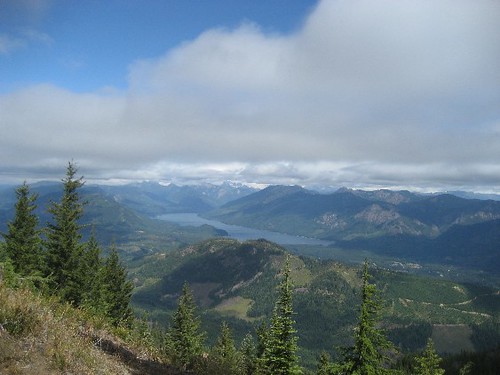
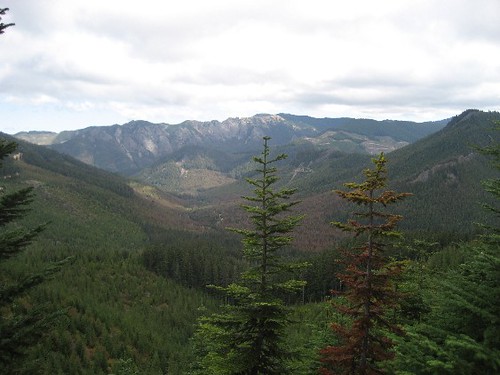

As you said, it'll be there next year. Hope you get your revenge. Thanks for sharing the report, I enjoyed reading it.
ReplyDeleteGreat report, Ben! I had the same experience climbing up to mile 60 last year. I had been struggling since Stampede Pass and nothing could get me back together. I had to lay down on the way up the trail so I have a good idea of how you felt.
ReplyDeleteI was amazed this year doing the last 32 miles coherent how difficult the last section is and how steep some of the drops off the cliff are after you leave Thorpe Mountain. Scary stuff!
Thanks for the report Ben. I'm sure it thrilled Rob "Rattler" Hester to hear that you saw a 400lb Black Bear along the same path that we met him on a bit earlier in the night. Heck you even got to see a skunk. All I got to see as far as wildlife goes is Olga at the start and a bunch of chipmunks. Did I mention the two yellowjacket nests I ran through? Of course I had to pay the yellowjacket toll of a few stings as I passed by. I guess that's better than rag dolling down a cliff. I don't see myself running the race again next year but I may pace someone. Depends on what happens with the WS100 Lottery this December.
ReplyDeleteHave you had a chance to run the Cardiac Needles yet? Lot's of "Hester Joy" (suffering) on these long chin scrapper climbs in the last 20 miles of CC100.
We will look forward to seeing you next year! Hopefully sometime sooner!
Eric "Trail Scat"
Eric,
ReplyDeleteI forgot to mention in my report that I got stung on the knee by a yellowjacket on one of the climbs. It swelled-up enough to make an aid station worker think I'd screwed my knee up.
Yes, I guess Olga qualifies as "wildlife."
I haven't done the cardiac needles section, yet. Maybe I should fly out special, just to do it.
I'm in the WS lottery, as well.
See you out West, somewhere.
Hey, no name calling!!! :)
ReplyDeleteBen, I liked it how you said "a good DNF". Since I have no regrets, I guess I had a good one too. Go figure...
Very nice written, and awesome pictures! Lets count on next year. I loved those views, we have a real beauty here, so blessed. Gotta see Cardiac Needles!
When is the next time I see you around? Besides when you bring Trail Nerds to PCT 50? :)
You'll never know. It could be sooner than you think.
ReplyDeletewow. sounds like an amazing endeavor. I'm sure you'll make it next year. Glad you are happy with the effort you put in. That rope section looks brutal!
ReplyDeleteTalk about Scenic! We're going to have to get out west and do one of those together before long! There's just something about them there mountains.
ReplyDeleteYep, the mountains keep drawing me back to them. I must've been a Mountain Man (or a bear) in a previous incarnation. Probably a bear; I like huckleberries a lot.
ReplyDeleteYup.. that convinced me to put this race on my "to do" list.
ReplyDeleteCongrats to you either way Ben. WAY TO GO!
Wow, excellent stuff Ben! It was a joy to read the experience. Much props! Thanks for the kind words as well. Great to see Stuart and his excellent accomplishment of 11 finishes.
ReplyDelete